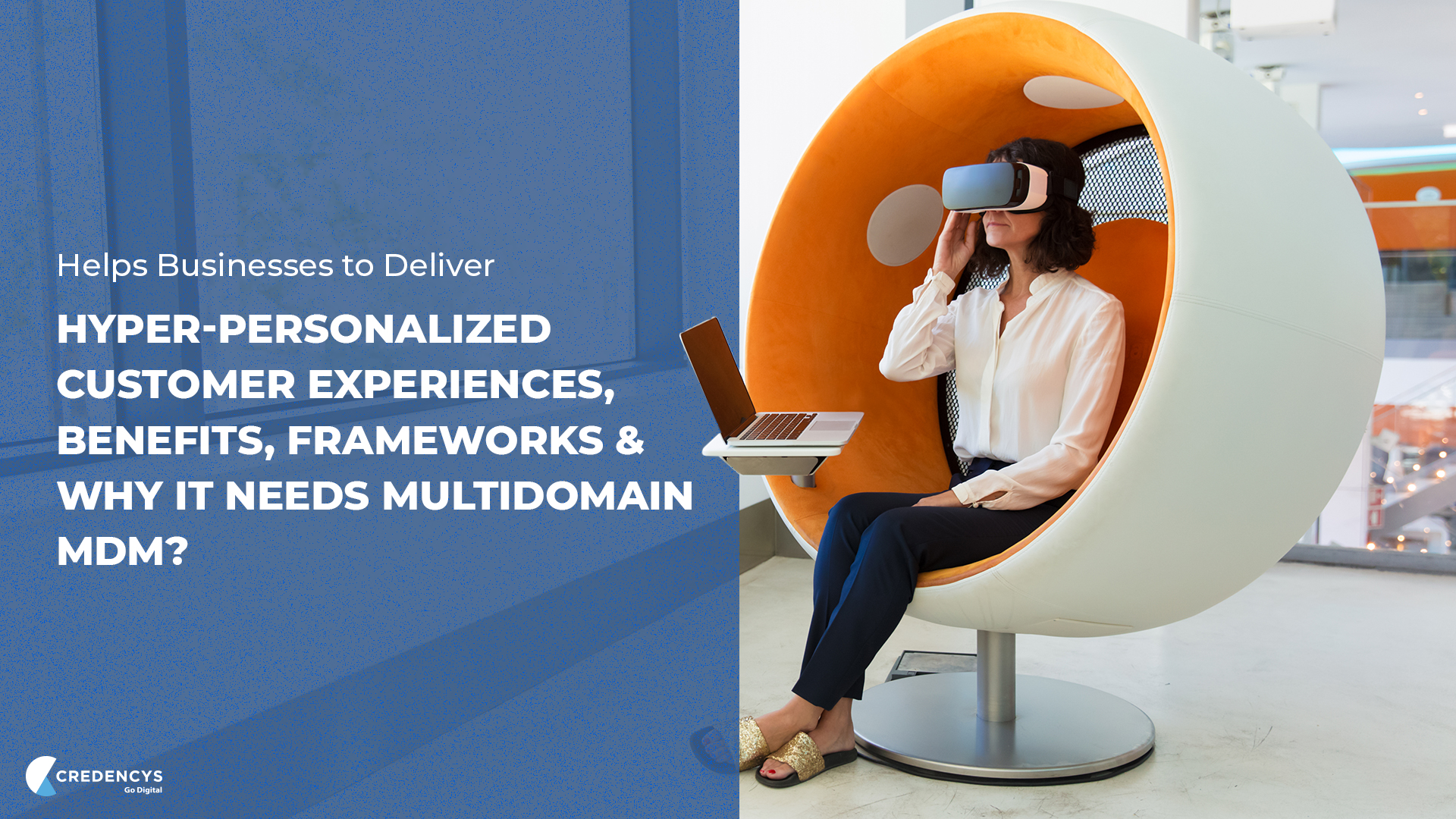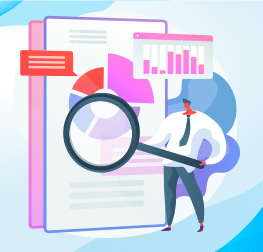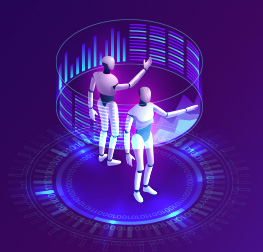All You Need To Know About Hyper-Personalized Customer Experiences, Benefits, Frameworks & Why It Needs Multidomain MDM?
In this world of growing business, every organization needs to develop themselves as per the customer needs. They need to develop and update their products based on their customer demands to gain their trust and confidence.
The organization can attract its customer’s attention by providing personalized communication and through customized experience. The customers prefer accepting the service from the organization that provides personalized care, products, and services.
What is hyper-personalization?
Due to digitalization, the organization can gather a lot of data related to their products and services as well as the data specific to their customers. The organization can make use of this advancement to collect the behavioral data of the customers to understand their needs and requirements.
It becomes possible to interpret the customer characteristic and develop product-centric marketing strategies. With this data, the organization can develop better personalized customer-centric marketing.
Hyper-personalization allows the gathering of real-time behavioral data from the customers related to the services, tailored products, and their experience based on their requirements.
For making this purpose easy, the organization needs to combine the product and customer data to collect data from multiple channels regarding their product experience, their needs, and requirements.
Hyper-personalization will allow in the collection of relevant accurately that will be the same in a lot of time. This helps in collecting efficient details related to the customer’s requirements and accordingly provides personalized products to them.
How does hyper-personalization differ from personalization?
It is important to understand how hyper-personalization is different from personalization. There are different forms of personalization definitions where the organization understands their customers and recognizes them by the different products they purchased and reviewed. Hyper-personalization is a more advanced technique that makes the use of artificial intelligence-driven methods for personalization.
The personalization that interacts with the customers with their emails or other contact details obtained from their previous purchases. Hyper-personalization gathers the customer needs and requirements from various sources. These details are in context from the different channels, locations, product categories, different brand interactions, etc.
Hyper-personalized framework & its benefits
There are different important steps involved in forming the best framework for this hyper-personalization. The essential steps required for designing the blueprint for the best hyper-personalized framework include:
Data collection
This is the first and the most important step responsible for identifying the audience. It is essential to understand all the customers distinctly based on their requirements. Having adequate details about the target customers will help in better personalization.
Customer segmentation
In this step, the customer data is split into various sub-segments for better personalization. These subgroupings are based on spending, demographics, contentment, location, and past interaction with the customers. This helps in improving customer engagement and adherence to the band.
Target exploration
After the segmentation, the next step involves setting the communication facet. There are different factors involved in engaging the customers.
Analysis
The final step of the framework includes the implementation of the calculation and examining the different measures for making this campaign successful.
The different benefits gained by an organization from the hyper-personalization include:
- It allows in removing the different obstacles in their sales channels that can lead to various complications in customer’s shopping experience. It helps to decrease the efforts and search time by the customers to get as per their requirements.
- It eases the burden from the customers and helps them in selecting the items that they want. This hyper-personalization uses the recommendation algorithm that allows displaying the products to the customers based on their needs.
- It is the best path that helps any brand to attract customers promptly and also retain the already existing ones. This is possible as it allows them in recognizing their customer’s interests and requirements. This helps the customers by saving time by providing the best and relevant solutions.
Creating a hyper-personalized customer experience
The customers while shopping prefers the business partners that will allow them to buy the best possible product or services based on their requirements. There is an increase in the targeted or personalized strategies that help in attracting customers. These techniques help the organization in taking their business to a higher level.
This hyper-personalization helps to enhance the real-time marketing of the products. This helps in improving the customer connection and leaving a better impression.
1. Understand real-time marketing
Real-time marketing is the best strategy that will help any business to target its customers. Based on the location, the customers can be prompted with the current sales and offers. This will trigger the customers to visit the store for making the purchase.
2. Know the customer
Based on the customer data, the marketing team can get an idea of the items or product category that the customer is currently focussing on. Based on their needs based on the category search, the customer can be prompted the details of related products that might interest them.
Sending out the survey sheets, polls and getting their responses will help in creating the detailed requirements. These will also help in understanding the customers and increasing the conversations. Based on the search details from customers will help to target the different customers.
3. Rapid follow-ups
Certain customers add their product of interest into their shopping cart but due to certain reasons, abandon their carts. They visit the product site but do not complete the purchase procedure. This customer can be prompted to purchase their selected product by giving them a helpful nudge to look into their filled cart and proceed with the purchase.
Based on the customer’s previous purchases, the company can prompt the customer for the upgraded or latest product belonging to a similar category that the customer prefers. If the customer is suggested with the trending product based on their likes and interests, they will be prompted to make the purchase.
4. Personalization
For providing hyper-personalization, it is essential to update the data and response from the customers. For this, they send out the survey sheets on a regular basis to understand the customer needs and requirements. Marketing the products that the customers are looking for is the best way to attract customers and increase the business.
Understanding the customers is essential for marketing. If the customer product list includes the makeup items related to the cruelty-free items, then suggesting similar types of products to the customers makes them feel that they are heard and their requirements are considered.
This will help to retain the customers and increase their purchases. Better understanding the customers helps in providing them the best services and products.
Why do hyper-personalized customer experiences need multidomain MDM?
Attracting more customers and retaining the original one is the most important task that the organization needs to take up. Customers prefer online shopping for the product of their desire.
There are various channels where the customers can search their requirements. It will be beneficial if these customers get hyper-personalized services on the various domains. The different factors that need to be considered while making personalization are available on multiple domains.
Multi-domain Master Data Management (MDM) provides personalization strategies:
The customer experience helps the organization to understand the customer needs. These details help in setting up the hyper-personalization strategies. The different ways that allow the multidomain MDM in achieving hyper-personalization include:
Governance capability
Multidomain MDM helps the business owner by providing them the important data elements required for personalization like product data, customer data, location data, channel data, etc.
Data quality
Multidomain MDM makes sure that all the data related to the customers, products, and other data used for the hyper-personalization is accurate, coherent, and complete.
Generate new data insight
Multidomain MDM does not generate any data on its own. It uses all the data that is readily available. It helps to compile all the data efficiently to yield new insights. This will help to generate information that will be helpful in hyper-personalization.
Different sources of data
MDM compiles the data from different sources like social media data, census data, etc. Combining these data efficiently with the master data records can help in revealing newer insights.
Use of analytics for personalization
Efficient customer interaction can help in generating a lot of crucial data that will help in understanding the customer demands and needs. It can be done based on direct interaction or the basis of various sources like surveys, channels, reviews, etc. MDM helps in generating the repository for collecting and sharing all this data. This will allow the business owner to create a coherent customer-centric experience for purchasing desired products.
Proper data collection
There are certain problems faced by the organization in collecting the customer’s data as there are different challenges. These include non-disclosure due to no consent to use the information, insufficient or lack of tools for collecting the data, management, and organization of the ill-defined objectives. MDM supports in overcoming these challenges. It helps in collecting all the data in a safe place and then collates the data efficiently. MDM ensured keeping the process of data collection transparent.
Multidomain MDM helps in moving from segmentation to personalization to hyper-personalization:
- Segmentation allows addressing a wider set of public or customers based on the set of demographic similarities like gender, demographic location, or region, etc. On the other hand, personalization takes into consideration the individual customers by understanding their needs and providing them the best suitable products and services.
- The personalization process is a very data-intensive process. The different aspects that define the customer experience are based on personalization accuracy, coherence, relevance, pertinence, timeliness, etc. Different recommendations tools that can adjust the experience will help them to prompt the relevant products to the customer based on their interests.
- Multidomain MDM helps to define the different zones of insight. It allows defining the unique cross-domain governance that leads to the development of effective hyper-personalization. These zones of insight are formed by the intersection of the different data domains like customer data, product data, location data, and supplier data.
The multidomain MDM makes use of and relies on the different types of data essential for hyper-personalization. These types of data include:
Event-based data
This includes the real-time data that directly impacts the individual and is related to the local information, local weather, device usage, behavior, etc.
Configuration-based data
This information is based on the individual configuration settings adapted by the user. This depends on their aspirations, needs, product preferences, content appearance, information alerts, consent information, etc.
Deduction-based data
This data includes the results based on the analytics. Based on the previous behavior or purchase of the customer, the next offer, eligibility, sentiment is considered.
The multidomain MDM helps to achieve the hyper-personalization in the following ways:
- It is important to have the governance strategy in place for an effective hyper-personalization. This required data transparency, relevance, better quality, coherence, etc. across the different channels. Multidomain MDM helps in having data transparency.
- It allows managing the different data domains and this information directly impacts the customer experience.
Brands doing hyper-personalization
There are some top brands like Amazon, Starbucks, Spotify, etc. that have gained their current positions in the market due to this hyper-personalization. These brands use machine learning and artificial intelligence techniques for setting up their privilege recommendation engine. These techniques help these brands to keep their customers engaged and attracted to their products.
Amazon
They provide a hyper-personalized experience for each of their customers. They have access to huge data regarding the search query, search history, brand fondness, category browsing, etc. They propose the items to their customers based on their previous browsing and items in the shopping cart.
Starbucks
They boost hyper-personalization by using real-time data and deliver the messages related to the different offers on the food and beverages based on their preferences and past activities.
Spotify
It understands the individual music selection and based on the category suggests some details by mails or text for similar live events.
Bottom line
Providing personalized service to the customers is beneficial to the business in many ways. This hyper-personalization includes several steps added to the conventional. This personalization helps in creating a better experience for each of their customers as their expectations keep growing with the increase in digital competence.
The organizations need to adopt the new techniques, approaches, and plan accordingly to make this personalization experience and achieve their goals.








Tags: